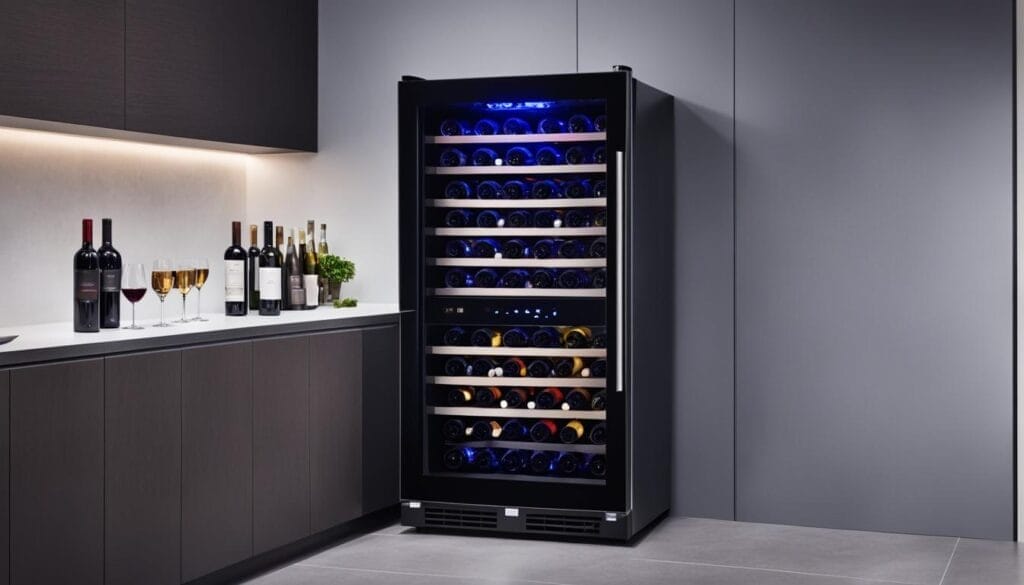As a wine enthusiast, you know how crucial it is to create the perfect environment for your wine collection. To maintain the optimal conditions, we need to understand how humidity affects the aging process and how to control it effectively. This guide will walk you through an essential aspect of wine storage: humidity control in a wine fridge.
When storing wine, the ideal humidity level falls between 50 to 70% RH (RH = Relative Humidity). This range ensures that the corks remain moist, preventing them from drying out and compromising the wine’s quality. However, the ordinary environment cannot generate humidity for preserving wines, so we need to find ways to adjust the desired humidity level.
There are various methods and tools available to help us manage humidity in a wine fridge. Following these steps, you can ensure that your wine is stored in a controlled and optimal environment for aging and preservation. Let’s get started!
Key Takeaways:
- Maintaining the proper humidity level (50 to 70% RH) is crucial for wine storage.
- Wine coolers cannot create humidity, so it’s necessary to add moisture to maintain the ideal conditions.
- Using a hygrometer can help monitor and determine if additional humidity is required.
- Placing a wet sponge inside the wine fridge is a simple method to add humidity.
- Consider investing in a wine fridge with integrated humidifiers for controlled humidity levels.

The Ideal Humidity Level For Wine Storage
Maintaining the ideal humidity level is essential when storing your wine collection. Wine is a delicate beverage that requires precise conditions to age gracefully.
The best humidity control wine fridge or wine cellar will provide an environment with humidity levels between 50 to 70% RH (relative humidity). This range is optimal for preserving the quality and flavors of your favorite bottles.
Why is humidity control important for wine storage? Let’s explore the reasons:
- Oxidization risk: If the humidity level drops below 50%, there is a higher chance of oxidization. Oxidized wine can develop off-flavors and deteriorate in quality.
- Mold formation: If the humidity exceeds 70%, mold and mildew may start to grow. This can ruin the wine labels, corks, and affect the taste of the wine.
Therefore, keeping the proper humidity level within the recommended range is crucial for preserving the integrity and taste of your wine collection. A wine fridge for proper humidity control or a humidity control wine cellar provides the ideal conditions to safeguard your investment.
Next, we’ll explore the inner workings of wine coolers and learn how they handle humidity control. Knowing the mechanisms behind these appliances will help you select the right wine storage solution.
Understanding Humidity In Wine Coolers
Wine coolers are primarily designed to keep the temperature and humidity level stable, preventing any fluctuations that could negatively impact the wine’s quality. By maintaining an optimal temperature and humidity, wine coolers slow down the aging process and preserve the freshness and flavors of the wines.
1. Monitoring And Maintaining The Humidity Level
To ensure the humidity level remains within the recommended range, it’s essential to monitor and regularly check the humidity levels in your wine cooler.
- A hygrometer, a device used to measure humidity, can be placed inside the wine cooler to provide accurate readings.
- In some cases, you may need to introduce additional humidity to the wine cooler. One simple method is to place a clean, wet sponge on a small tray inside the cooler. As the water evaporates, it naturally increases the humidity.
- Alternatively, if you’re looking for a more advanced solution, there are wine coolers available with integrated humidifiers. These coolers can provide precise control over the humidity levels, ensuring your wine is stored in optimal conditions.
2. Benefits Of Controlling Humidity In Wine Coolers
Controlling humidity in wine coolers offers several benefits:
- Preserves the quality and flavor of the wines by preventing oxidation
- Maintains the integrity of the corks, preventing them from drying out
- Reduces the risk of mold formation
- Creates a stable and consistent environment for wine storage
- Allows wines to age gracefully and develop complex flavors
Ways To Add Humidity To A Wine Fridge
By utilizing simple methods, you can add humidity and maintain the optimal conditions for storing your precious wine collection. Here are some of practical approaches for controlling humidity in your wine fridge.
1. Using A Hygrometer
- A hygrometer is a handy device that measures the humidity level in your wine cooler.
- It helps you determine if additional moisture is needed to achieve the ideal range of 50 to 70% RH.
- By regularly monitoring the humidity, you can take necessary actions to maintain the optimal conditions for your wines.
2. Placing A Wet Sponge
- An effective way to add humidity to a wine cooler is by placing a clean, wet sponge on a small tray inside the fridge.
- As the water evaporates, it creates moisture and increases the humidity level.
- This simple yet practical method helps prevent the corks from drying out and ensures the wines remain in excellent condition.
3. Using A Wine Cooler With Integrated Humidifiers
- To simplify the process of humidity control, you can opt for a wine cooler with an integrated humidifier.
- These specialized refrigerators come equipped with built-in systems that allow you to regulate and maintain the desired humidity levels.
- It’s essentia to consistently monitor the humidity levels and make adjustments as needed. By ensuring proper humidity control in your wine cooler, you can preserve the flavors, aromas, and quality of your favorite wines for years to come.
| Method | Advantages | Disadvantages |
|---|---|---|
| Using a Hygrometer | – Provides accurate humidity measurements – Easy to use and monitor | – Requires manual adjustment of humidity levels – Additional equipment |
| Placing a Wet Sponge | – Simple and cost-effective – Natural way to increase humidity | – Requires regular maintenance – Increased risk of mold if not managed properly |
| Using a Wine Cooler With Integrated Humidifier | – Precise humidity control – Convenient and hassle-free | – Higher upfront cost – Limited options in the market |
Controlling Humidity In A Wine Cellar
1. Construction & Cooling System
Maintaining the ideal humidity level in a wine cellar includes factors such as the cellar’s construction, insulation, and ventilation, as these can affect humidity levels.
- Proper insulation and sealing techniques help prevent outside air from entering the cellar, which can cause fluctuations in humidity.
- Installing a cooling system specifically designed for wine cellars is the best option, as it can manage both temperature and humidity.
- Creating a vapor barrier and installing a temperature and humidity gauge can also help control and monitor humidity levels. In some cases, running a dehumidifier may be necessary to lower humidity levels.
- Ventilation is crucial to allow air circulation and prevent stagnant conditions that may lead to mold growth. A well-ventilated cellar helps maintain a consistent humidity level throughout the cellar space.
2. Creating A Vapor Barrier
In order to control humidity effectively, it is recommended to create a vapor barrier in the wine cellar.
- A vapor barrier is a layer of material, such as plastic sheeting, that prevents moisture from seeping through the walls or floor.
- This barrier helps maintain a stable humidity level within the cellar, preventing excessive moisture absorption from the surrounding environment.
3. Temperature And Humidity Gauge
- Monitoring the humidity level inside the wine cellar is essential to ensure it remains within the desired range.
- Installing a temperature and humidity gauge allows you to regularly check and adjust the humidity as needed.
- These gauges provide accurate readings and help maintain the ideal conditions for wine storage.
4. Dehumidification
- In certain situations, the humidity levels in a wine cellar may exceed the desired range.
- This can occur due to factors such as high humidity in the surrounding environment or poor ventilation.
- In such cases, running a dehumidifier can help lower the humidity and create a more suitable environment for wine storage.
By controlling the humidity levels in a wine cellar, wine enthusiasts can ensure that their collection is stored in the optimal conditions for aging and preservation.
| Factors | Impact on Humidity |
|---|---|
| Construction | Affects the stability of humidity levels |
| Insulation | Prevents outside air from causing fluctuations |
| Ventilation | Ensures proper air circulation and prevents mold growth |
| Cooling System | Regulates both temperature and humidity |
| Vapor Barrier | Maintains stable humidity levels |
| Temperature & Humidity Gauge | Monitors and adjusts humidity levels |
| Dehumidification | Helps lower humidity if levels are too high |
Bottom Line
Overall, proper humidity control is crucial for preserving the quality of your wine collection. Whether you’re using a wine fridge or a cellar, maintaining the ideal humidity level between 50 to 70% RH is essential. By monitoring and controlling humidity, you can ensure that your wine ages gracefully and remains in optimal condition for your enjoyment.
Creating a proper ventilation and cooling system, a vapor barrier and installing a temperature and humidity gauge can help you monitor and maintain the desired humidity range in your wine storage.
Remember, by prioritizing humidity control for wine storage, you can savor your favorite bottles at their best. Cheers to perfectly preserved wines.
Happy cooling!
FoodiesFridge










